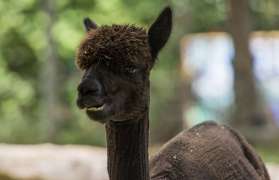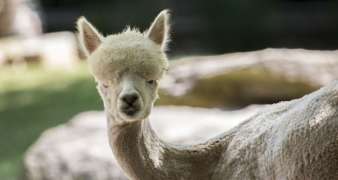Huacaya Alpaca
Huacaya Alpaca
Alpacas are a domesticated, social species that live in herds. Although they originated in Peru, they have now spread worldwide in human care. Although they share similar characteristics and are often mistaken for one another, alpacas and llamas are different species! There are four South American camelids: the alpaca and the llama, both domesticated, and the vicuña and the guanaco, both wild species that diverged from a common ancestor around 2 million years ago.
Vicugna pacos
Herbivore
South America
Mountains, Urban Areas
Zoo Atlanta has Huacaya alpacas. Listen closely when you are nearby. You can often hear them vocalizing! They may even come to visit you at the fence.
Photos and Videos
Alpacas are descendants of the wild vicuña and were domesticated by Andean people over 6,000 years ago. Today they are kept primarily because of their extremely soft fleece, which is used to spin into yarn for textiles. Alpaca farms are found worldwide.
Alpacas have a slender body, long neck, small head and long, pointed ears. They weigh 110 to 190 pounds and are around 3 feet tall at the withers (the highest part of their back). Their most noticeable trait is the soft fleece, also called fiber, covering their bodies. There are two breeds of alpacas: the Huacaya (pronounced wah-KI-ah) and Suri (SOO-ree). Zoo Atlanta has Huacaya alpacas, which are the more common of the two and have a wooly, fluffy appearance. Suri have a silkier, straighter fleece texture. There is a lot of variation in alpaca color! There are 22 natural alpaca fiber colors, including varying shades of white, black, brown and grey. It might look like sheep wool, but their fiber is warmer, lighter and stronger! They are usually shorn once per year, depending on climate, with males producing around 8 pounds of fiber and females producing around 5 pounds.
Males’ incisor and canine teeth, called fighting teeth, will grow longer than females’ do, but this is the only characteristic that makes them sexually dimorphic, meaning they don’t have any other distinguishing features that differentiate them.
Alpacas are social animals that live in herds that sometimes include other animals like goats, llamas and sheep. A male alpaca is called a macho, and females are hembras. Offspring are called cria until they are 6 months old. Alpacas can breed year-round. They are “induced ovulators,” meaning that females have no regular heat/estrous cycles, but instead females ovulate after breeding with a male. Males will mate with multiple females. Gestation is 242 to 345 days. Crias are precocial, meaning they can stand and move around on their own shortly after birth. Crias weigh around 17 to 33 pounds at birth, and are weaned at 6 to 8 months old.
Alpacas communicate through body language, vocalizations and possibly through dung piles.
The most common vocalization heard is humming, but other sounds include snortling, mothers clucking to crias, grumbling, screeching, and alarm calls. Alpacas, like other camelids, will spit at one another when threatened but rarely intentionally spit at humans.
Alpacas were domesticated by Andean people around 6,000 years ago and still play an important role in the South American economy today. In addition to their fiber, their meat is eaten, their skin is used for rugs, clothing, purses and toys, and their dung is used as fertilizer and fuel. Their role was and is similar to that of the buffalo of the Great Plains in North America, with the difference being that alpacas are domesticated and buffalo were not.
Zoo Atlanta has Huacaya alpacas. Listen closely when you are nearby. You can often hear them vocalizing! They may even come to visit you at the fence.
Originally domesticated by the Andean people of Peru, these animals can now be found all over the world.
Their ancestors lived in humid mountainous regions, but these domesticated animals can be found in any kind of habitat in human care.
Alpacas are domestic animals. They eat grasses and are fed hay and browse.
Alpacas are a domesticated species, so there are no wild alpacas.
Their ancestor and closest wild relative, the vicuña, is currently listed as Least Concern, although they were previously listed as Vulnerable due to over-hunting. Crossbreeding the vicuña and alpaca does produce fertile offspring that has a desirable, high-quality fiber, although this does not happen in nature. There are concerns that excessive hybridization for commercial purposes could have negative effects on the vicuña.


